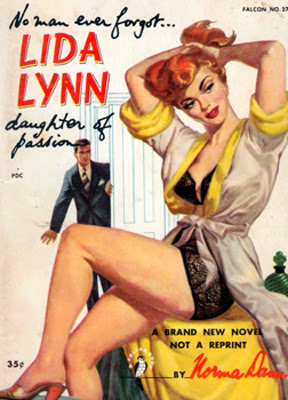Norman Daniels (Norman Arthur Danberg, 1905-1995) was a prolific author that experienced tremendous success in the pulp market before creating a second career writing numerous paperback originals, novelizations, and television tie-ins in a variety of genres. He used a multitude of pseudonyms and even collaborated with his wife Dorothy, a sensational paperback writer that specialized in gothic-romance titles. I presented the author's life and literary work on a podcast episode HERE, but wanted to provide a text on this workaholic writer that has seemingly vanished from the reader radar.Here's a Paperback Warrior Primer on Norman Daniels.
Norman Arthur Danberg was born in 1905 in Connecticut. He attended both Columbia and Northwestern University. Daniels' first published story was "The Death House Murder", which appeared in Detective-Dragnet magazine in 1932. That same year he saw his stories in magazines like The Shadow Detective Monthly, All-Detective Magazine and Gangster Stories. The December 1933 issue of Thrilling Detective featured a story called “Cold Steel”. This was an important moment for Daniels because it secured a relationship with the pulp powerhouse Standard, which was owned by Ned Pines. They produced a ton of titles in the 30s and 40s and competed with the equally productive publisher Street & Smith.

Daniels not only created The Black Bat, he also had a hand in writing, and if not outright creating, a slew of other titles like Dan Fowler G-Man, The Crimson Mask, The Eagle, The Candid Camera Kid, Captain Danger, The Masked Rider, Range Riders as well as also writing for the rival Street and Smith publisher with their pulps like The Avenger, Crime Busters, Doc Savage, The Feds and the popular The Shadow Magazine.
The author's Masked Detective character debuted in Masked Detective in 1940. It ran for 12 total issues with a 13th story appearing in Thrilling Mystery. Daniels wrote the first few issues of the series before handing the project off to the other work-horse authors of that era like Sam Merwin Jr. and W.T. Ballard. I reviewed the first appearance of the character HERE.
The author proved to be extremely busy in the 1940s writing shorts for the likes of Romantic Range, Army-Navy Flying Stories, Popular Detective, G-Men Detective, Sky Fighters, Clues Detective Stories, Crack Detective Stories, Thrilling Detective, and Exciting Navy Stories.
The birth of the paperback in the 1950s would be a welcome mat for Daniels to increase his productivity. Using a variety of pseudonyms, Daniels went to work on creating a number of full-length novels that appeared in paperback format. While he was writing for this new format, he continued to write shorts for the magazines and pulps like Western Romance and Mystery Detective. But his paperback output really flourished at this time.

While writing a lot of 1950s paperbacks, Daniels also wrote television scripts. According to IMDB, Daniels penned scripts for shows like Alfred Hitchcock Presents, Sugarfoot, Colt. 45, Zane Grey Theater, Ford Theater and General Electric Theater among others. In the 1960s, Daniels incorporated television novelizations and tie-ins into his repertoire with books based on shows like Arrest and Trial, Sam Benedict, The Smith Family, Chase, The Detectives, Ben Casey, Dr. Kildare, The Avengers, etc.
Also in the 1960s, Daniels created an eight-book spy series called The Man from A.P.E. starring a secret agent named John Keith. That series ran from 1964-1971. I read and reviewed the debut HERE. Daniels also wrote a two book series of spy novels starring a CIA agent named Bruce Baron. These were The Baron of Hong Kong from 1967 and Baron's Mission to Peking from 1968. He also wrote a stand-alone spy novel called Spy Hunt in 1960 (reviewed HERE). He wrote for a number of other publishers in the 1960s including several WW2 novels like Moments of Glory, Battalion, and Strike Force (aka Killer Tank, reviewed HERE).
Daniels also wrote another short series starring a California police chief named Kelly Carvel. These books were The Rape of a Town in 1970 followed by One Angry Man in 1971 and concluding with License to Kill in 1972. I reviewed the series debut HERE.
Daniels also submerged himself into the marketable medical thriller and hospital trend. He authored titles like The Surgeon, Savage Heart, Jennifer James RN, Stanton Bishop MD and The Tarnished Scalpel.
In the 1970s, Norman Daniels began delving into the gothics genre. Daniels wrote many of them under the name Angela Gray. Some title names were The Ashes of Falconwyk, Ravenswood Hall, Watcher in the Dark and The Warlock's Daughter. He also wrote them under the name Suzanne Somers. These had titles like Mists of Mourning, Until Death, The House on Thunder Hill and House of Eve. He also used the name Cynthia Kavanaugh to pen gothic romances like The Deception and Bride of Lenore. He also wrote at least one under the name Geraldine Thayer, a novel titled The Dark Rider. Daniels even wrote some gothic-romance novels under his wife's name to leverage her market value and name.Norman Daniels was very prolific because he knew the paperback trends and pop-culture. He wrote what was popular at the time and hinged much of his success on what was selling at the cinema. If spy films were popular then he wrote espionage thrillers. Once the gothic market took off he was quick to jump into that concept. When WW2 and high-adventure became a trend, Daniels was quick to place his efforts in that niche.
Norman Daniels died in Camarillo California in 1995. Much of his literary work, journals, notes and manuscripts were donated to Bowling Green University where they remain available for anyone wishing to browse the author's work. His wife Dorothy, who sold over 10 million copies and wrote over 150 novels, passed away in 2001.
























